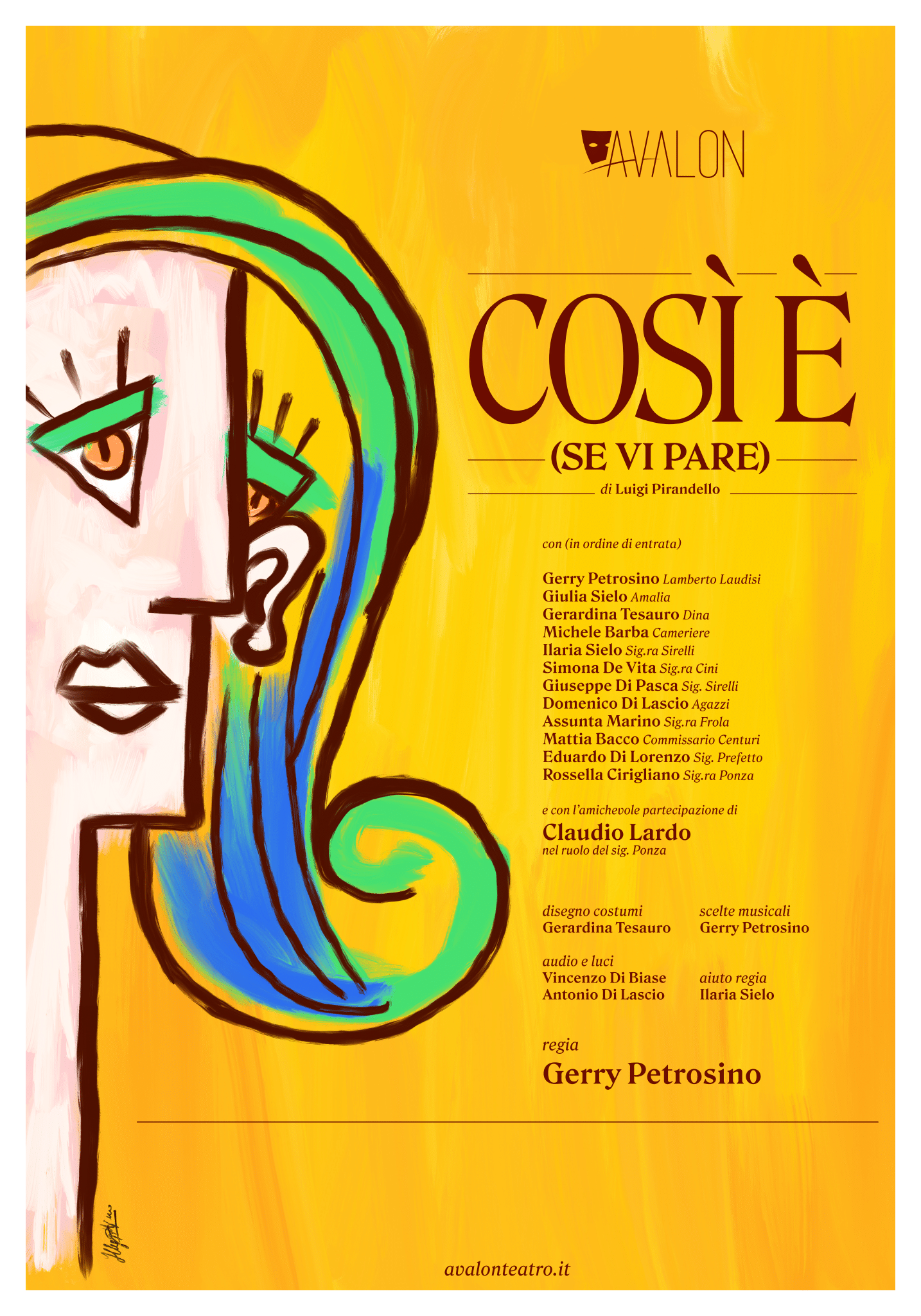by
Luigi Pirandello
with (in order of appearence)
Gerry Petrosino
Giulia Sielo
Gerardina Tesauro
Michele Barba
Ilaria Sielo
Simona De Vita
Giuseppe Di Pasca
Domenico Di Lascio
Assunta Marino
Mattia Bacco
Eduardo Di Lorenzo
Rossella Cirigliano
assistant director
Ilaria Sielo
costumes
Gerardina Tesauro
musical selection
Gerry Petrosino
audio and lights
V. De Biase e A. Di Lascio
with friendly participation of
Claudio Lardo
directed by
Gerry Petrosino
Trailer (1')
The truth: what is it? Does it really exist? Or rather: is there only one truth? This eternal and fascinating Pirandellian question perhaps finds its utmost expression in this work. Pirandello, through the character of Lamberto Laudisi, drags the protagonists of this comedy into a "tangle" that they struggle to understand and, because of this, it vexes them; and so, we see them persist in a feverish and surreal search for truth: "any kind, as long as it is, in fact, categorical." Approaching a literary giant like Pirandello, for the direction of this work, an imprint strongly tied to the Futurist influences typical of the historical period in which the author lived and conceived much of his literary production has been chosen. In every choice made, from the sets to the costumes, to the music, there is a reference to the Futurist movement or, in any case, to artistic movements that even before the writing of the text could have influenced Luigi Pirandello. Born in Italy during a period of transformation and great technological discoveries, Futurism brings with it the very idea of change, movement, and speed.

It is, therefore, the common thread that accompanies the spectator from the beginning to the end of the show, but in fact, going deeper, it is ART in all its expressions that finds a place in this representation, in which almost every character recalls, in a more or less obvious way, a painting by a 20th-century artist: from Klimt to Tamara De Lempicka, from Schiele to Guttuso. The characters become, at times, paintings themselves, remaining motionless in plastic poses that transport them out of the course of events and then drag them back into the story in a succession of actions and "still images" that contribute to making this staging incredibly psychedelic.
Equally important is the symbolic value of blatantly anachronistic elements, which serve to highlight, even more marked, the speed of a time that flows inexorably; this applies to both concrete elements - such as some details of the costumes - and intangible elements - like the music. And it is precisely in the use of musical accompaniment that we find again the philosophy of all of Pirandello's comedy: the choice to alternate diegetic music with extradiegetic music is dictated precisely by the desire to create a strange atmosphere suspended between what is real and what is not. There is, of course, a reference to the political influences of that period that fascinated - albeit only in an initial phase - Luigi Pirandello. But even here, the reference passes through a form of art adhering to the Futurist movement: the reproduction of Renato Bertelli's sculpture, in this case, has the dual purpose of representing the influence of fascist ideology (which undoubtedly that symbol represents), but also the ambiguity of an object that deceives the observer's eye, remaining the same from any angle it is viewed. Nothing is left to chance, therefore: everything that will be seen on the stage is the result of careful reflection and study; a reflection and study that the director tries to express through an original approach, in an attempt and in the hope of never being predictable or banal. Naturally, the spectator has the final word: RIGHT YOU ARE, IF YOU THINK SO! (COSÌ È, SE VI PARE!)
Offida (AP), Teatro Serpente Aureo
October, 18th 2025
Aprilia (LT), Teatro Finestra
March, 22nd 2025
Santeramo in Colle (BA), Teatro "Il saltimbanco"
March, 16th 2025
Battipaglia (SA), Teatro sociale "Aldo Giuffré"
April, 26th 2024
Minturno, Teatro del Castello
December, 30th 2023
Pesaro, Teatro "Gioacchino Rossini"
October, 28th 2023
Battipaglia (SA), Teatro sociale "Aldo Giuffré"
April, 29th 2023

 Italiano
Italiano